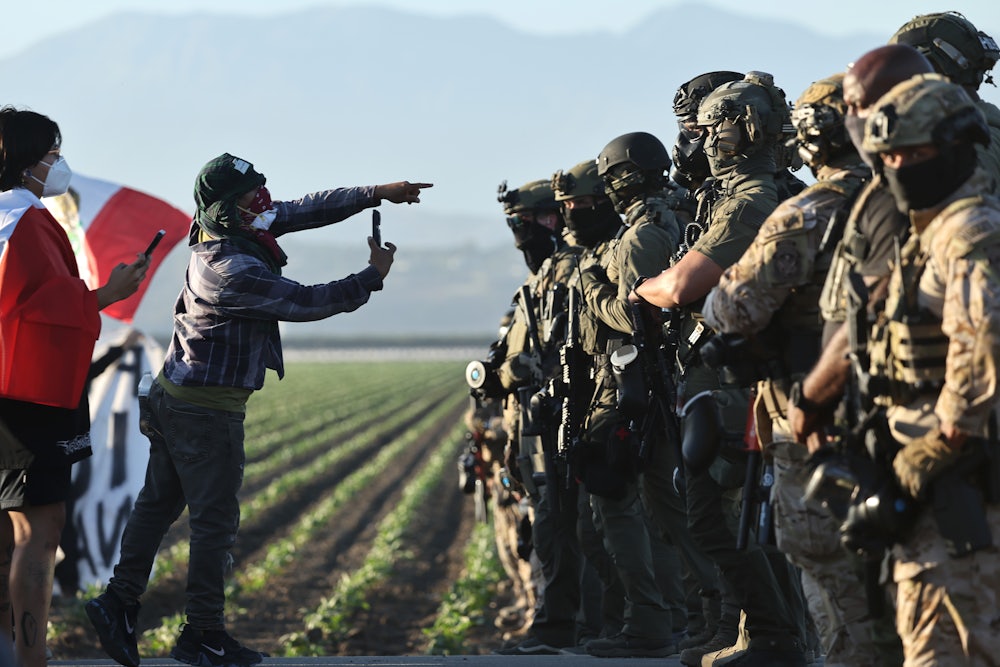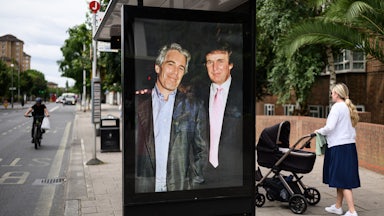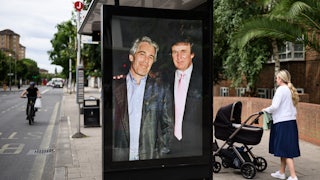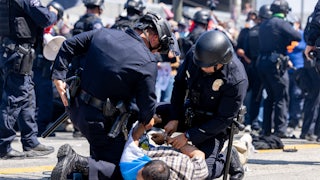In California, well before federal immigration agents reach their targets, their regular, brutal raids are sometimes augured by a video. “They passed Ventura, entering Santa Barbara, 10am,” read the caption on an Instagram post the morning of Thursday, July 10. Shot through the windshield of a moving car on the freeway, it showed a line of vans, SUVs, and other large vehicles, the type often spotted at raids. “Fucking caravan, you guys—fucking caravan,” a voice in the car added. The footage was reposted by two immigrant rights groups in Ventura County, 805 Immigrant Coalition and VC Defensa. Then it spread over social media. A few hours later, an ABC7 news chopper hovered over the scene as Immigration and Customs Enforcement agents descended on farms near Camarillo.
It was late afternoon on the East Coast when I opened the news station’s live feed on YouTube. Almost instantly, I felt sick. From high overhead, the chopper’s camera zoomed in on ICE agents in an apparent standoff, their vehicles parked in dusty brown earth at the roadside, as if abandoned. Striding around casually while dressed for war, agents could be seen lining up farm workers. Some agents stood a few feet from a stretcher with a person lying on it.
All told, the arrests a week ago may add up to the largest single roundup yet by this administration. According to the Department of Homeland Security, more than 300 people were arrested in the raids on farms in Camarillo and Carpinteria. But the arrests did not target only workers. Additional federal agents, their faces covered with neck gaiters and reflective sunglasses, launched smoking canisters into the group of witnesses and community members gathered behind a length of flimsy yellow police tape drawn across the road. Stacks of water bottles appeared roadside, to drink and as an eye flush in case of tear gas. This was direct action more than protest; few, if any, signs could be seen. People were putting their bodies in ICE’s way, a rolling vigil over hours. Periodically, different witnesses raised their phones aloft, pointing them at officers blocking the road. The whole thing was recorded from so many angles. At times, individuals stood motionless, inches from the front of the federal agents’ vehicles.
The live feed of the arrests and protests, almost completely silent except for an eerie mechanical buzz, went on for hours, too. It was numbing to watch until those moments when the scene seemed to mark itself for future inclusion in a documentary series or a civil rights case (or a news story). That quantity of footage may be too much to consume, especially on top of the myriad videos that demonstrators themselves shot and shared on Instagram, TikTok, and Bluesky. As available as all of this material was, a record right at our fingertips, the simple facts of the raid could get submerged. Breaking news stories euphemistically described an “immigration enforcement action” and “clashes”—a disingenuous term that suggests equal force on both sides—between protestors and federal agents.
But the story is both clear and simple: Federal agents arrested workers at a large commercial farm near Camarillo, and federal agents also arrested the people who came out to defend the workers. Defending workers is something Californians have been doing in rising numbers for weeks now, ever since Trump’s close advisor, Stephen Miller, and Trump’s “immigration czar,” Tom Homan, selected California residents as the people to be made an example of in their contemptible national crackdown. This week marked the fortieth day of ICE raids in California, during which an estimated 3,000 people have been arrested, and 2,000 National Guard and 700 active-duty Marines remain stationed in Los Angeles.
In mid-June, Border Patrol released a video of its agents, also faceless and in full gear, making arrests in Los Angeles. The video, titled “A Relentless Mission – LA Protests – U.S. Border Patrol,” underlines the extent to which these “immigration enforcement actions” are deliberately choreographed displays of power, meant to suppress and shrink immigrant communities and political opposition alike. The raids are spectacles, designed for the rest of the country to applaud or fear, in which immigrants are scapegoated and dissenters are punished for the cameras: a cautionary action-horror movie playing out in real time.
In addition to the Border Patrol, National Guard and police blockaded access to the farms, reported Mel Buer, an independent journalist in Los Angeles who has been covering the response to ICE raids. “But people,” she wrote, “came anyway.” Arriving as the sun set, Buer could hear them chanting well before she reached them. She saw more than 100 demonstrators facing down “a thick line of Border Patrol agents and National Guard kitted out in riot gear–helmets, gas masks, and shields.” Angelmarie Taylor, a student at California State University Channel Islands and part of 805 Immigrant Coalition, was one of those demonstrators. “We are average community members who have been volunteering our time to patrol our own streets to keep each other safe from these ICE agents,” Taylor said on Democracy Now on Friday. While the federal agents harmed the demonstrators and violated their rights, she said, those agents used “even more intense violence” on the farmworkers themselves.
Also among the witnesses and protesters was Jonathan Caravello, a professor at California State University, whom Taylor said had been targeted for speaking out in defense of the immigrant community. After he was arrested on Thursday, Caravello vanished for days. The California Faculty Association, Caravello’s union, condemned his “abduction and disappearance,” and said they were still working to locate him. “The Trump Administration’s barbaric attacks on peaceful observers aim to force people of good conscience into silence and complicity while Trump tears our nation apart,” said Arnulfo De La Cruz, President of SEIU Local 2015 and Executive Board Member of SEIU California. CFA and SEIU California jointly called for the release of all the people who were taken by immigration agents in the raid on Thursday and for “a stop to all immigration raids, immediately.”
Late Monday afternoon, Caravello was released from federal detention. Unusually, federal prosecutors did not announce the charges against him until Sunday, and when they did, it was in a post on X by Bill Essayli, the interim U.S. attorney for the Central District of California. The same office is pursuing federal charges against an activist who brought face shields to distribute at a protest, to protect people from chemical agents used by police. In the Department of Justice, such overreach is now par for the course: The day after Caravello was released, federal prosecutors in Spokane, Washington, charged a group of protestors, including the former city council president, for “conspiracy to impede or injure officers.” Most of those who were charged in Spokane had merely blocked a bus carrying people whom ICE had detained, a type of intervention we are seeing now across U.S. cities. “This politically motivated action is a perversion of our justice system,” said Spokane Mayor Lisa Brown. In bringing such specious prosecutions, the Trump administration is hunting for ways to criminalize people who oppose the ICE raids, including those engaging in nonviolent self-defense.
Protestors are not a monolith. In opposing the raids, they offer a range of arguments and tactics. Some defend the contributions of immigrant workers. Some do practical work like documenting ICE raids. But the point of these raids is to demonstrate that no one, no matter what they contribute to the community, will be spared arrest. In fact, some, including citizens and elected officials, were targeted precisely for their contributions. Ultimately, neither “good” immigrants nor “good” protestors can use their goodness as a shield from ICE’s violence.
Trump’s campaign of “mass deportations” was never just about carrying out more immigration raids. We knew this campaign would reach far beyond those immigrants who are living in the country without authorization—not just because the number of people he said would be deported exceeds the numbers of undocumented, but because his plans also involve making more and more people deportable. Sure enough, some of the workers who were detained in the July 10 raids were citizens, the United Farm Workers said in a statement. George Restes, a disabled veteran and American citizen, was arrested and held for three days without a phone call, he said, and without treatment after agents pepper sprayed him. These detentions may have been aimed at managing perceptions of the raid. The UFW pointed out that many of those detained reported being released only “after they were forced to delete photos and videos of the raid from their phones.”
ICE’s project goes well beyond the violent scenes of the raids: It has transformed everyday life in California. Family pets are filling Southern California shelters, given up by owners who have been forced to leave the United States. At a Glendale hospital, ICE agents camped out for days, scaring people away from seeking care; National Nurses United shared Know Your Rights guides for all health care workers. Countless children are left waiting for parents to return, like 16-year-old Alexa, whose pregnant mother was arrested Thursday, forcing Alexa to become the caretaker for her younger siblings until their mother returns. Other family members of missing workers, including their young children, went to the farm the next day, hoping to be reunited. The family of Jaime Alanís, one of the workers gravely injured in the chaotic raid, reunited with him in the hospital, where he died on Saturday. His surviving family members have said that he will be brought to Huajumbaro, Michoacán, his hometown: “His wife and daughter are waiting for him.”
People have long asked themselves what they would do when faced with something like these mass roundups and detentions—an injustice of historic proportions. Until recently, this question may have seemed to be asking you to imagine yourself into the past. But then the Trump administration opened an American concentration camp in the Everglades. What would you do? You would do what you’re doing right now.
Now it is becoming routine in California for armed agents, without warning or cause, to arrest and detain and deport the people who have, for years, been vilified by an unpopular regime leader. That’s why any resistance to these raids is being met with such fierce repression and reprisal. Seeing the evidence of the roundups in front of us doesn’t necessarily lead people to do anything differently. But seeing other people push back sometimes does.






